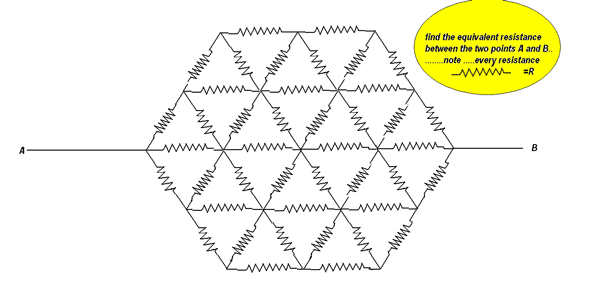Solve this physics problem

Thanks to all who join this discussion and make it a success....Anyone willing to solve the problem is welcomed. Enjoy it ...!!
No vote yet
10 votes
Easy Math Editor
This discussion board is a place to discuss our Daily Challenges and the math and science related to those challenges. Explanations are more than just a solution — they should explain the steps and thinking strategies that you used to obtain the solution. Comments should further the discussion of math and science.
When posting on Brilliant:
*italics*or_italics_**bold**or__bold__paragraph 1
paragraph 2
[example link](https://brilliant.org)> This is a quote# I indented these lines # 4 spaces, and now they show # up as a code block. print "hello world"\(...\)or\[...\]to ensure proper formatting.2 \times 32^{34}a_{i-1}\frac{2}{3}\sqrt{2}\sum_{i=1}^3\sin \theta\boxed{123}Comments
The correct answer is 330299R≈.906R.
Using Pranav A.'s method of folding the circuit, and then applying a Delta-Y transformation (http://en.wikipedia.org/wiki/Y-%CE%94transform), I was able to reduce the circuit to a 13-resistor,10-node circuit(https://i.imgur.com/OQ0t9f8.png). From there, you can use the Node-Voltage method (http://en.wikipedia.org/wiki/Nodalanalysis), along with assuming a test voltage applied across A and B, to solve the circuit, although it requires using a rather large system of equations. If anyone knows of a way to further reduce the circuit from the 13-resistor state so that you don't have to get such a large system please tell me.
Log in to reply
I too had the same problem. I had to apply the Y-delta transform again and again but it wasn't ending up with nice values so I gave up.
IF ANYONE OF YOU FIND THIS PROBLEM IN A BOOK,DON'T THINK I HAVE COPIED IT....I CREATED IT MYSELF....
Log in to reply
Do you know the answer?
Log in to reply
no, sorry i don't know it..but if anyone describes me how to approach, i could understand....
Thanks Ricky E. !! ... You've been brilliant.
Log in to reply
Is that a pun on the word brilliant? lol! :P
I am not sure about it but first step is obviously folding the circuit about AB. This step retains only the half portion of circuit with all the resistors equal to R/2 except the middle line of four resistors which still have R resistance. The second step involves removing "fake" nodes but I still need to figure out those nodes.
Log in to reply
there is a great theory to compute the equivalent resistance of such big complicated circuits of resistance....it opines that if any system of resistance is symmetrical about its two opposite point here the two points "A" and "B" then all the points equidistant from this two terminal would be at same potential ......i knew this fact or theorem but i don't know how to apply it here.......i think it would have to be applied here.....try it....
Very complicated......
Log in to reply
What are the values of the resistors...are they all same or different
Log in to reply
you have not seen the whole problem..... i have written it in the right corner........ however, each and every resistor have equivalent resistance=R.......
Image Link I simulated this problem. these resistors have 21/19R ohms. I think It is hard to solve by hand.
Turns out to be 'R' (I think so)
well really...... current had to do lot of hard work!!!!! please clearly mention your problem, the question is not clearly visible.
Delta Y transformation is the only way(known to me), and you will definitely need a good calculator!!
first we change the delta connection into star connection and now we solve it easy series and parallal combination
Log in to reply
would you please elaborate it....?...i'm unaware of these connections.....
Log in to reply
http://en.wikipedia.org/wiki/Y-%CE%94_transform
Consider each resistor 'R' Fold the circuit along AB. When resistors overlap, consider it a parallel combination and replace it by 'R/2'.
So, except the 4 resistors in the AB line, you get half the circuit where each resistor is 'R/2'. Now, draw a line of symmetry along the perpendicular bisector of AB. There are two nodes on this line, the mid point of AB and the midpoint of the bottom line. Remove these connections as follows : for the top:
something like --------- ^
and for the bottom, something like : v
Now use the normal laws and solve the problem.
Log in to reply
What's your answer??
I think the answer is 52R/45.